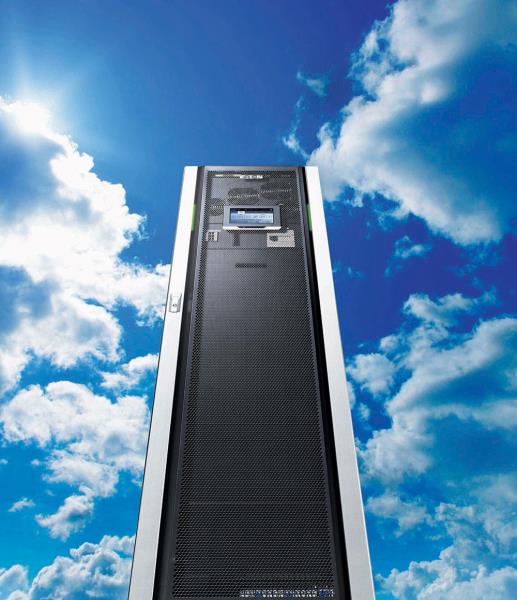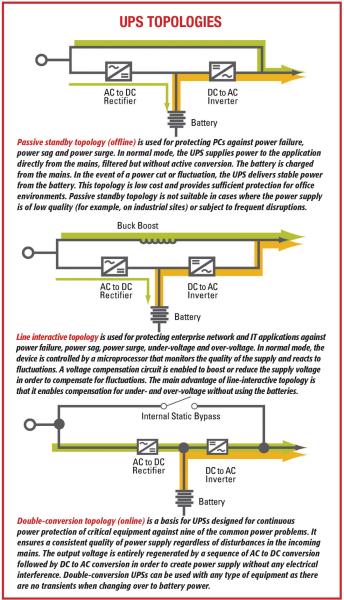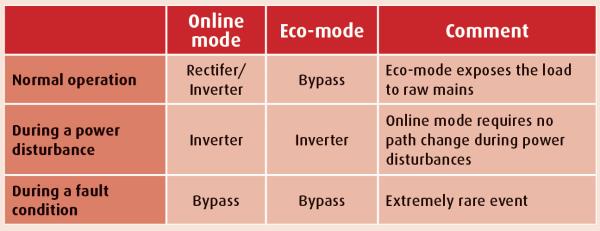29 March 2015

Double-conversion UPS devices, such as the Eaton 93PM shown here, ensure clean and reliable load power irrespective of mains quality.
Almost every aspect of industry and commerce today is critically dependent on having continuous access to IT resources. But this uninterrupted access can only be assured if those resources receive electrical power that is reliable and free from disturbances.
In itself this is nothing new. But there is a fresh challenge facing designers of power systems for IT applications: the quality of power provided by the public supply network is likely to deteriorate, at least for a time, as the transition is made to renewable energy sources and older power plants are shut down because they do not meet current environmental standards.
The supply network was designed to receive power from a relatively small number of large generating plants that had very predictable outputs. Now the network is being asked to receive power from a large number of smaller energy sources with much less predictable outputs.
It is simply not possible to reconfigure the network overnight to cope fully with such an enormous change. But until this work is complete, which may be many years, supply quality is likely to be compromised, with voltage and frequency variations much more common than they were in the past.
This means that there is now a greater need for ways of safeguarding the supply of power to key assets in order to ensure business continuity. In critical applications, this most often takes the form of an uninterruptible power supply.

Resiliency vs. efficiency
The UPS must make sure that at any given time the load receives clean and reliable power regardless of the condition of the mains supply. It must protect the load against many types of power quality problem, including not just long- and short-term supply interruptions, but also frequency and voltage variations, transient voltages, harmonic distortion, and more.
Advances in technology and the growing ‘digitalisation’ of the world mean that many more IT applications must now be considered critical.
At the same time, environmental concerns have been increasing along with the cost of power. This leaves UPS users with difficult choices to make about achieving the right balance between resiliency and efficiency, as it has traditionally been considered that it is necessary to make sacrifices in one of these areas to make gains in the other.
UPS manufacturers are now addressing this conundrum. The latest products combine lowest total cost of ownership, achieved by providing new standards in efficiency and superior scalability features, with exceptional resiliency supported by innovative technology and design.
One way this is being done is by using double-conversion topology. This means that the incoming power is processed in two-stages: from AC to DC via a rectifier; and from DC to AC power to the load. Double-conversion UPSs are acknowledged as providing the best possible protection for loads as they ensure clean and reliable power to load irrespective of the quality of the mains supply.
In the past, double-conversion was considered to have a potential short-
coming: its two power conversion stages both contribute losses meaning efficiency had to be sacrificed in favour of protection.
But thanks to two recent technological advances this is no longer an issue.
The first of these is the development of novel high-efficiency power converters based on the latest IGBT (insulated-gate bipolar transistor) technologies. This has enabled the overall efficiency of the latest UPSs to be raised to an exceptional 97 per cent when operating in double-conversion mode.
The second development is a new energy saving technology based on powerful algorithms that allow the UPS to operate on a ‘double-conversion on-demand’ basis, determined by the quality of incoming mains.
In the best examples, the transition between energy saving mode and double-conversion mode is seamless and extremely fast (less than 2ms), and is therefore invisible for the load.
As a result of these developments, users can benefit from the unmatched security and quality of supply that only double-conversion UPSs can provide, while also enjoying reduced energy bills, which will ultimately provide big savings in TCO. A further benefit is that the high efficiency of such UPSs means that they generate less heat, so users also save on cooling costs.
Other key features offered by the latest UPSs include paralleling technology and battery management. Paralleling allows more UPSs to be added to an existing installation as user requirements grow, providing convenient and cost-effective scalability without any risk of compromising resilience or reliability. Battery management extends battery life by as much as 50 per cent by charging batteries only when they need it rather than continuously float charging them.

Jorge Aguinaga,
Manager,
Three Phase UPS Product Management,
Eaton Power Quality Business EMEA
Power management
Another area which has seen developments recently is the power management software available with the UPS. Key things to look out for here are whether the software is fully compatible with all major operating systems and all popular virtualisation software, therefore enabling the UPS to be easily integrated into almost any IT environment.
Power management software will ensure monitoring and managing UPS installations is convenient and straightforward, with users made instantly aware of any changes in power status.
The most advanced examples of power management software can also arrange for these status changes to trigger automatic actions, such as the transfer of VMs from physical servers where mains power is no longer available to others where the mains supply is secure. This is another important aid to security and resilience.
The digitalisation of the world combined with an increased mix of renewables is increasing the need for clean and reliable power. This, combined with the ever-increasing quest to develop cost-effective solutions and reduce environmental impact, is creating challenges never
seen before in UPS systems.
Thankfully, there are now a number of advancements in UPS technology which enables the design of power systems for IT applications to be adapted to meet these challenges accordingly.
Eco-mode: the benefits and risks of operating UPS systems with energy-saving modes
Neil Rasmussen, SVP of innovation, Schneider Electric

Neil Rasmussen
Eco-mode is very similar to the basic mode of operation used in an offline UPS where it is called ‘standby’ or ‘line interactive’ mode.
In these traditionally smaller, single-phase UPSs, the inverter/rectifier circuits are ‘offline’ or are not part of the normal power path. In normal operation therefore, the load is exposed to essentially raw mains power from the utility. This mode of operation is similar to what occurs with a double-conversion online UPS that is operating in traditional eco-mode.
All large double-conversion online UPSs are equipped with a ‘static bypass’ path that provides multiple features including acting as a source of redundancy for the power inverter.
There are two main paths that can supply the load, the online (double-conversion) path and the bypass path. Note that the load is connected to the raw, unconditioned mains power when the bypass is active (in this context, ‘raw power’ has the same voltage, waveform, frequency, grounding system and impedance as the mains). The following table shows when each path is used in both online and eco-mode operation:
Note in online operation, the UPS uses the bypass path only when there is a fault. In the life of the UPS, this is an infrequent event and may actually never happen. Therefore in online mode, the critical load is not subject to power disturbances, even during a mains power problem. In eco-mode, any mains power abnormality causes the UPS to switch power paths between bypass and inverter.
In online mode, the UPS continuously regenerates the output voltage. In eco-mode the load is normally powered by the bypass path, allowing raw mains power to supply the load, and the UPS inverter is engaged only when the utility mains fails. So in eco-mode the UPS inverter operates in ‘standby’ and in principle, this is just a simple change
in the control software of the UPS.
The benefit of eco-mode is that the efficiency of the bypass path is typically between 98-99 per cent, compared to the base UPS efficiency of 94-97 per cent. This means there is a pickup in UPS efficiency of between 2-5 per cent in UPS efficiency when eco-mode is used.
Eco-mode will save energy, although the amount saved is surprisingly small. In addition, the energy saved comes at some reduction in electrical protection and reliability. This penalty will vary depending on the design of the electrical architecture such as in a data centre and on the UPS vendor’s specific design approach used in implementing eco-mode functionality.
The cost of eco-mode is that the IT load is exposed to raw utility mains power without the conditioning normally provided by the double-conversion, online UPS. The UPS must continuously monitor the mains power and quickly switch to the UPS inverter when a problem is detected, and before the problem can affect the critical load.

This may sound simple but it is actually quite complicated as eco-mode entails a number of risks. It introduces a number of new modes of operation of the data centre, and reduces power protection. Complex systems comprised of a mix of IT equipment, transformers, transfer switches, and other possible non-IT loads are less predictable in their response to infrequent and unusual power events, and their compatibility with eco-mode is less certain.
It is important to note that different vendors implement eco-mode differently: there are variations in the way the system operates the standby inverter and in the way the mode is enabled, and where it will revert to normal UPS mode under various conditions.
Some firms claim to have special patented ways to control their transfer switch. But they all have the same basic concept of exposing the critical load to unconditioned power and transfer events in return for a small percentage gain in efficiency.
While advanced eco-mode offers advantages over standard mode, it does come with a trade-off. Since the inverter circuit is ‘on’ in advanced mode, overall UPS efficiency is less than it would be if it operated in standard mode. However the difference is small, having been observed to be typically in the 0.5-1.0 per cent range. So while advanced eco-mode efficiency is less than standard eco-mode, it is still better than traditional online mode.
Eco-mode represents a potential way to save energy in UPS applications, and data centre operators can expect to see savings of around 2-3 per cent in total energy if it is enabled. Higher per cent savings are possible if the data centre is operated at very light electrical loads.
But the energy savings associated with eco-mode are getting smaller as newer generation UPS systems improve in efficiency. The advent of advanced eco-mode has significantly reduced the (already rare) risks but has done so at only a small cost in efficiency compared to standard eco-mode.
The operation of eco-mode is like the hand-off of a baton in a relay race. It is critical that it works correctly, as each hand-off is a little different and, on very rare occasions, there may be a problem.
For this reason, eco-mode should be used in situations where the number of hand-offs are as few as possible, e.g. where power quality is excellent. n
This is an edited version of a white paper first published by Schneider Electric at www.schneider-electric.com in August 2014. Neil Rasmussen has since retired.
-(002).png?lu=245)







